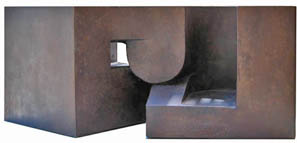Neil
Ferber's father was a child refugee from Germany in the 1930s, who
remained in England after the war and married an Englishwoman. Neil
was born in Wales and educated in Cardiff. He became interested
in art while still at school, making models and objects in a shed
at the bottom of his parents' garden. He went to Bulmershe College,
Reading where he studied sculpture under Dennis Harland and Alf
Parks. He has always avoided following fashionable or commercial trends in art, believing in the traditional values of fine art techniques. Through a period of many varying styles and trends, Neil has consistently worked in an abstract mode, modelling in clay or wax and casting sculptures in a variety of modern materials, experimenting with different textures and finishes. His work is architectural, constantly exploring the relationships of mass and space. The main influences throughout his career have been European - looking towards Brancusi and Eduardo Chillida. |
||||||||
 |
||||||||
Neil
Ferber's sculpture is formal in that it does not represent anything
external to itself. The works are compositions arising from the
use of traditional sculptural elements such as mass, plane, line,
weight and space. |
||||||||
He
has no preconceived idea of what a sculpture will look like and
prefers to discover a work through a process of trial and error
using clay or wax, continually putting clay on and off until he
finds ideas which he can blend into a visual whole. This is a totally
intuitive process, one that is informed by many years of working
in this way. Ideas arrive and are then discarded until Neil feels
that a certain combination has a particular quality of unity and
presence. He strives to make pieces that are fully three dimensional, that have no front, back or sides, where all views are equally interesting. For Neil, a sculpture needs to be more than a collection of views, but to have a feeling of unity in space, an inner logic. If this can be achieved, the question of viewing angles does not arise. Once the form is arrived at in clay it has to be transferred to a more permanent material, usually plaster, which allows for further refinement before being carved in stone or cast in another material - usually either marble or bronze. |
||||||||
 |
||||||||
In
2005 Neil was invited to establish a studio in Peralta, Tuscany,
as sculptor in residence. Peralta is a small medieval hamlet restored
by the Italian Sculptor Fiore de Henriquez. Neil worked there for
6 years before moving to the nearby town of Pietrasanta, the Italian
‘citta d'arte', close to the Carrara marble quarries. The town has
had a history of sculpture-making since Roman times and is famous
for being the place where Michaelangelo came to work on ‘David'.
It is the perfect place for a sculptor to work and take advantage
of the many studios and foundries that still flourish. |
||||||||
Music
has always been a big part of Neil's life and contemporary improvised
music and modern jazz have both had a major influence on his work,
sharing similar characteristics of improvisation and abstraction.
For eighteen years Neil promoted British improvised music in his
spare time and organised the Appleby Jazz Festival, commissioning
new music and recording with the BBC. Neil's
sculptures are in private collections in Italy, Sweden, England
and the USA. |
||||||||
Copyright Neil Ferber... Sitemap... Kathleen Jones... Peralta